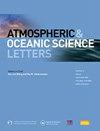Synoptic background conditions and moisture transport for producing the extreme heavy rainfall event in Valencia in 2024
IF 3.2
4区 地球科学
Q3 METEOROLOGY & ATMOSPHERIC SCIENCES
引用次数: 0
Abstract
From 26 October to 2 November 2024, Spain experienced a record-breaking rainfall event, with the most intense episode appearing in Valencia Province. During the event, Turis station recorded a historic 24-hour precipitation of 710.8 mm, exceeding the national annual average. This resulting flood led to widespread disruption and significant societal impacts. Synoptic analyses reveal that the event was dominated by a deep cut-off low extending through the entire troposphere and persisting for approximately 186 h. Background conditions were characterized by upper-level divergence, mid-tropospheric warm advection, and a strong southeasterly low-level jet, which promoted vertical motion and sustained moisture transport. The steep, funnel-shaped terrain along the eastern Iberian coast further triggered and enhanced the local convection. A 10-day backward Lagrangian moisture tracing using the HYSPLIT model identified the Mediterranean Sea as the primary moisture source (78.1 %), followed by northwestern Africa (8.5 %) and central-eastern Europe/the Black Sea (6.2 %). Low-level moisture transport was mainly driven by the cut-off low and a persistent Mediterranean high, while mid- to upper-level trajectories were associated with a preceding low-pressure system over the Mediterranean and the subtropical Atlantic high. These systems acted in sequence to relay moisture toward the Valencia region, and under the influence of the strongly rotating and convergent cut-off low—along with terrain-induced lifting—this moisture was rapidly uplifted, ultimately triggering the extreme rainfall event.
摘要
2024年10月26日至11月2日, 西班牙瓦伦西亚省遭遇罕见极端降雨, Turis站24小时降水量达710.8毫米, 引发严重洪涝灾害. 此次事件由持续186小时的深厚切断低压主导, 在高层辐散, 中层暖平流与低空东南急流共同作用下形成强垂直运动, 东海岸漏斗地形进一步增强对流. HYSPLIT后向追踪显示, 水汽主要来自地中海 (贡献率78.1 %), 其次为非洲西北部 (8.5 %) 和欧洲中东部/黑海 (6.2 %). 水汽由多个天气系统接力输送至瓦伦西亚, 最终在切断低压旋转辐合和地形抬升作用下, 引发此次破纪录降雨事件.
产生2024年瓦伦西亚极端强降雨事件的天气背景条件和水汽输送
从2024年10月26日至11月2日,西班牙经历了一次破纪录的降雨事件,其中最强烈的一次出现在瓦伦西亚省。在这次活动中,Turis站记录了历史性的24小时降水量710.8毫米,超过了全国年平均水平。由此产生的洪水造成了广泛的破坏和重大的社会影响。天气学分析表明,此次事件以一个贯穿整个对流层的深切断低压为主,持续时间约186 h。背景条件以高层辐散、对流层中暖流和强烈的东南低空急流为特征,促进了垂直运动和持续的水汽输送。东部伊比利亚海岸陡峭的漏斗状地形进一步触发和增强了局部对流。利用HYSPLIT模式进行的10天后向拉格朗日水汽追踪发现,地中海是主要的水汽来源(78.1%),其次是非洲西北部(8.5%)和中欧/东欧/黑海(6.2%)。低空水汽输送主要受切断低压和持续的地中海高压驱动,而中高层水汽输送则与地中海上空的低压系统和副热带大西洋高压有关。这些系统依次将水汽传递到瓦伦西亚地区,并在强烈旋转和辐合的切断低气压的影响下,以及地形引起的抬升作用下,水汽迅速上升,最终引发了极端降雨事件。摘要2024年10月26日至11月2日,西班牙瓦伦西亚省遭遇罕见极端降雨,Turis站24小时降水量达710.8毫米,引发严重洪涝灾害。此次事件由持续186小时的深厚切断低压主导, 在高层辐散, 中层暖平流与低空东南急流共同作用下形成强垂直运动, 东海岸漏斗地形进一步增强对流. HYSPLIT后向追踪显示,水汽主要来自地中海(贡献率78.1%),其次为非洲西北部(8.5%)和欧洲中东部/黑海(6.2%)。水汽由多个天气系统接力输送至瓦伦西亚, 最终在切断低压旋转辐合和地形抬升作用下, 引发此次破纪录降雨事件.
本文章由计算机程序翻译,如有差异,请以英文原文为准。
求助全文
约1分钟内获得全文
求助全文
来源期刊

Atmospheric and Oceanic Science Letters
METEOROLOGY & ATMOSPHERIC SCIENCES-
CiteScore
4.20
自引率
8.70%
发文量
925
审稿时长
12 weeks
 求助内容:
求助内容: 应助结果提醒方式:
应助结果提醒方式:


